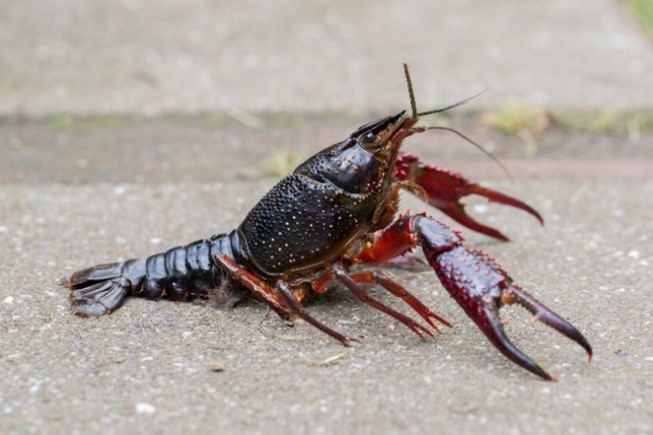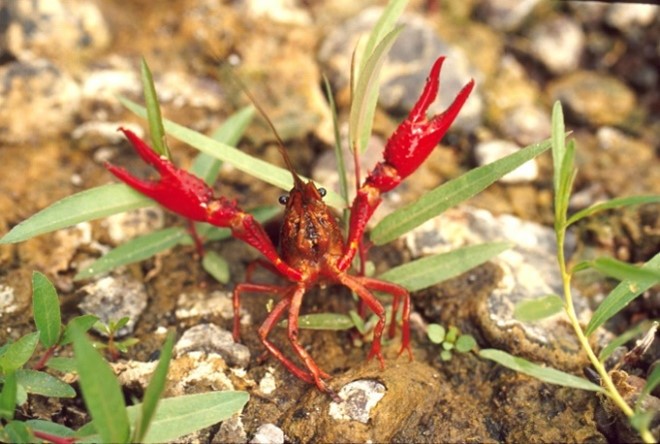Red swamp crayfish
Learn about red swamp crayfish and how you can help prevent the introduction and spread of this invasive species.
What Ontario is doing
To prevent this unwanted invader from coming into the province, Ontario has regulated red swamp crayfish (Procambarus clarkia) as a prohibited invasive species under the Invasive Species Act, 2015.
Learn about the Invasive Species Act and regulations.
Background
Red swamp crayfish is an aggressive invasive crayfish. They are found in various freshwater habitats with muddy or sandy bottoms and a large amount of organic debris. They can tolerate a wide range of:
- salinities
- pH
- oxygen levels
- temperature
- pollution
Like other crayfish, they are considered an ecosystem engineer, capable of impacting ecosystem processes with the potential to affect all species in the area.
Red swamp crayfish are commonly raised for human consumption and have been reportedly used as bait by anglers. Sometimes sold as a “freshwater lobster,” they are kept as aquarium pets due to their deep red colour.
Range
Red swamp crayfish are native to the southeastern United States, specifically the Gulf Coast from Florida to Mexico and the Mississippi River to southern Illinois and Indiana.
Red swamp crayfish have been introduced to Europe as well as many other U.S. states, including the watershed of Lake Michigan and into the Sandusky Bay of Lake Erie in Ohio in 1967.
Although currently not found in Ontario waters, the population in the Sandusky Bay is slowly expanding.
View an up-to-date distribution map of red swamp crayfish in North America.
Impacts of red swamp crayfish
The diet of the red swamp crayfish can accumulate large toxins that may be transferred up the food web.
In areas where red swamp crayfish populations grow large, their feeding behaviors may reduce the density of aquatic plants and decrease critical habitat in the ecosystem.
They may also overconsume species such as amphibians, small fish and molluscs while outcompeting native crayfish for these resources.
Burrows built by red swamp crayfish can destabilize stream banks or human infrastructure.
The diet of the red swamp crayfish can accumulate large toxins that may be transferred up the food web.
How to identify red swamp crayfish
The adult crayfish are 5.5 to 12 cm long. The adult’s body is also dark red, and the claws and head are elongated.
The head, claws and mid-body segment are covered in small red bumps.
What you need to know
- Learn how to identify red swamp crayfish and how to prevent the introduction or spread of this animal to Ontario’s waterways.
- It is against the law to import, possess, deposit, release, transport, breed/grow, buy, sell, lease or trade red swamp crayfish in Ontario.
- Never buy, keep or breed red swamp crayfish as a pet or for any other purpose. They may be listed under synonyms such as freshwater lobster.
Reporting illegal activity
If you have any information about the illegal importation, distribution or sale of red swamp crayfish, report it immediately to either:
- the ministry at
1-877-847-7667 , toll-free anytime - Crime Stoppers anonymously at
1-800-222-TIPS (8477)
If you’ve seen red swamp crayfish or another invasive species in the wild, please:
- contact the toll free Invading Species Hotline at
1-800-563-7711 - visit EDDMapS Ontario
- search for the ‘Invasive Species in Ontario’ project on iNaturalist.org to report a sighting
Gallery
Photo: Luc Hoogenstein, Wikimedia Commons
Photo: U.S. National Parks Services, Wikimedia Commons

